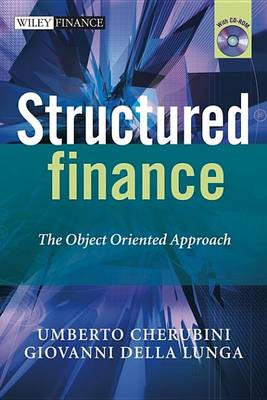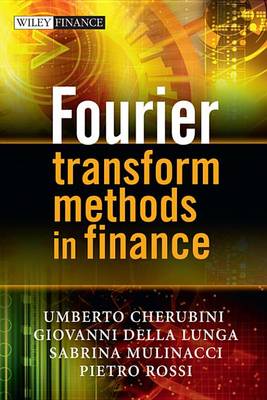The Wiley Finance
4 primary works
Book 269
Copula Methods in Finance
by Umberto Cherubini, Elisa Luciano, and Walter Vecchiato
Published 1 January 2004
"Copula Methods in Finance" is the first book to address the mathematics of copula functions illustrated with finance applications. It explains copulas by means of applications to major topics in derivative pricing and credit risk analysis. Examples include pricing of the main exotic derivatives (barrier, basket, rainbow options) as well as risk management issues. Particular focus is given to the pricing of asset-backed securities and basket credit derivative products and the evaluation of counterparty risk in derivative transactions.
Book 419
Structured Finance: The Object Orientated Approach is aimed at both the finance and IT professionals involved in the structured finance business with the intention of sharing common concepts and language within the industry. The financial community (structurers, pricers and risk managers) view structured products as collections of objects under the so-called replicating portfolio paradigm. The IT community use object oriented programming (OOP) techniques to improve the software updating and maintenance process. For them structured products are collections of objects as well. Despite use of the same object concept, it looks like communication between these different professional functions has been problematic. Recently, construction of standard data structures known as FpML has begun to lay out a common definition of objects, at least for plain vanilla derivatives, both between IT and financial people and across different market players.
Along this line, this book builds upon the concept of object to provide frontier treatment of structured finance issues relevant to both communities engaged in building, pricing and hedging products and people engaged in designing and up-dating the corresponding software. Structured Finance: The Object Orientated Approach will enable you to: * decompose a structured product in elementary constituent financial objects and risk factors (replicating portfolio)* understand the basics of object oriented programming (OOP) applied to the design of structured cash flows objects* build your own objects and to understand FpML data structures available for standard products* gauge risk exposures of the objects in structured products to: risk factors, their volatilities and the correlation among them (which factor are you long/short? Are you long/short volatility? Are you long/short correlation?)* update your risk management system to accommodate structured products with non linear exposures and to design objects to represent, price and hedge, counterparty risk
Along this line, this book builds upon the concept of object to provide frontier treatment of structured finance issues relevant to both communities engaged in building, pricing and hedging products and people engaged in designing and up-dating the corresponding software. Structured Finance: The Object Orientated Approach will enable you to: * decompose a structured product in elementary constituent financial objects and risk factors (replicating portfolio)* understand the basics of object oriented programming (OOP) applied to the design of structured cash flows objects* build your own objects and to understand FpML data structures available for standard products* gauge risk exposures of the objects in structured products to: risk factors, their volatilities and the correlation among them (which factor are you long/short? Are you long/short volatility? Are you long/short correlation?)* update your risk management system to accommodate structured products with non linear exposures and to design objects to represent, price and hedge, counterparty risk
Book 524
Fourier Transform Methods in Finance
by Umberto Cherubini, Giovanni Della Lunga, Sabrina Mulinacci, and Pietro Rossi
Published 11 December 2009
In recent years, Fourier transform methods have emerged as one of the major methodologies for the evaluation of derivative contracts, largely due to the need to strike a balance between the extension of existing pricing models beyond the traditional Black - Scholes setting and a need to evaluate prices consistently with the market quotes. Fourier Transform Methods in Finance is a practical and accessible guide to pricing financial instruments using Fourier transform. Written by an experienced team of practitioners and academics, it covers Fourier pricing methods; the dynamics of asset prices; non stationary market dynamics; arbitrage free pricing; generalized functions and the Fourier transform method.
Readers will learn how to: compute the Hilbert transform of the pricing kernel under a Fast Fourier Transform (FFT) technique characterise the price dynamics on a market in terms of the characteristic function, allowing for both diffusive processes and jumps apply the concept of characteristic function to non-stationary processes, in particular in the presence of stochastic volatility and more generally time change techniques perform a change of measure on the characteristic function in order to make the price process a martingale recover a general representation of the pricing kernel of the economy in terms of Hilbert transform using the theory of generalised functions apply the pricing formula to the most famous pricing models, with stochastic volatility and jumps. Junior and senior practitioners alike will benefit from this quick reference guide to state of the art models and market calibration techniques.
Not only will it enable them to write an algorithm for option pricing using the most advanced models, calibrate a pricing model on options data, and extract the implied probability distribution in market data, they will also understand the most advanced models and techniques and discover how these techniques have been adjusted for applications in finance. ISBN 978-0-470-99400-9
Readers will learn how to: compute the Hilbert transform of the pricing kernel under a Fast Fourier Transform (FFT) technique characterise the price dynamics on a market in terms of the characteristic function, allowing for both diffusive processes and jumps apply the concept of characteristic function to non-stationary processes, in particular in the presence of stochastic volatility and more generally time change techniques perform a change of measure on the characteristic function in order to make the price process a martingale recover a general representation of the pricing kernel of the economy in terms of Hilbert transform using the theory of generalised functions apply the pricing formula to the most famous pricing models, with stochastic volatility and jumps. Junior and senior practitioners alike will benefit from this quick reference guide to state of the art models and market calibration techniques.
Not only will it enable them to write an algorithm for option pricing using the most advanced models, calibrate a pricing model on options data, and extract the implied probability distribution in market data, they will also understand the most advanced models and techniques and discover how these techniques have been adjusted for applications in finance. ISBN 978-0-470-99400-9
Book 627
Dynamic Copula Methods in Finance
by Umberto Cherubini, Sabrina Mulinacci, Fabio Gobbi, and Silvia Romagnoli
Published 1 January 2011
The latest tools and techniques for pricing and risk management This book introduces readers to the use of copula functions to represent the dynamics of financial assets and risk factors, integrated temporal and cross-section applications. The first part of the book will briefly introduce the standard the theory of copula functions, before examining the link between copulas and Markov processes. It will then introduce new techniques to design Markov processes that are suited to represent the dynamics of market risk factors and their co-movement, providing techniques to both estimate and simulate such dynamics. The second part of the book will show readers how to apply these methods to the evaluation of pricing of multivariate derivative contracts in the equity and credit markets. It will then move on to explore the applications of joint temporal and cross-section aggregation to the problem of risk integration.


